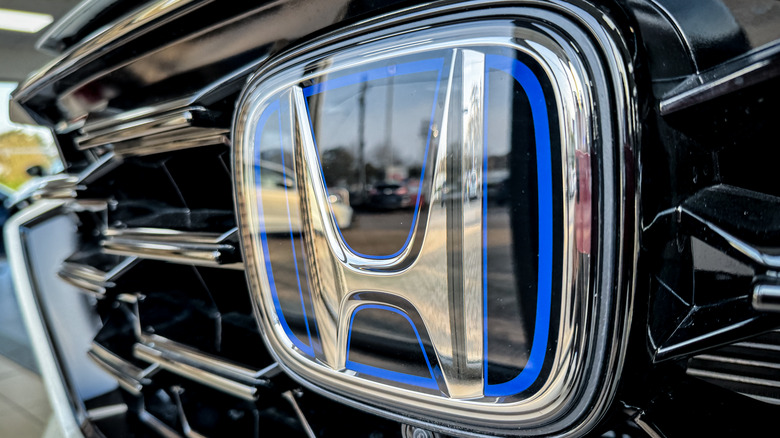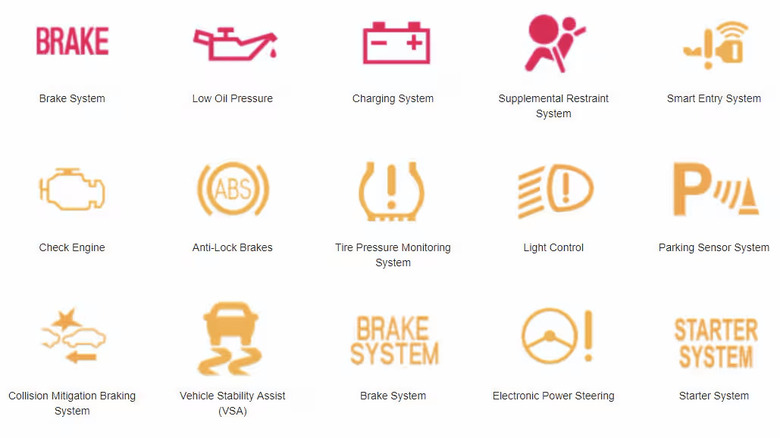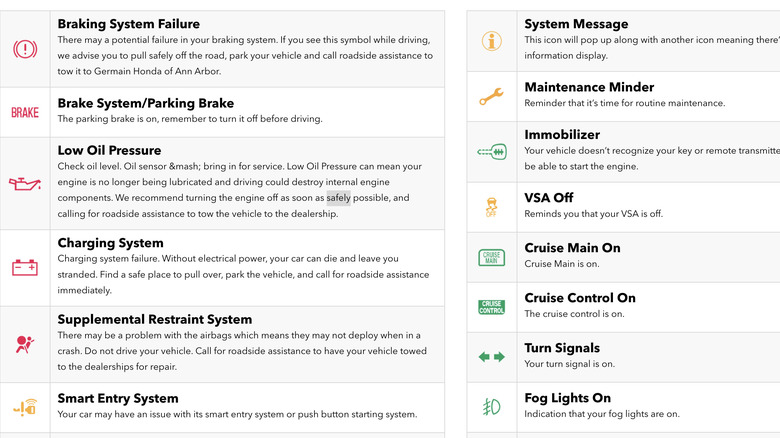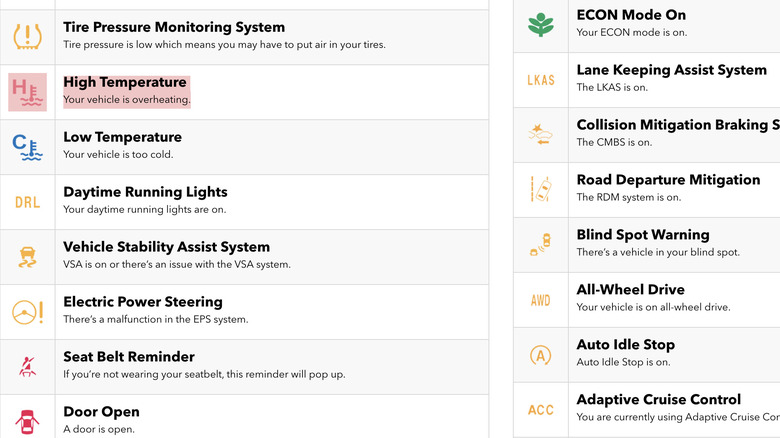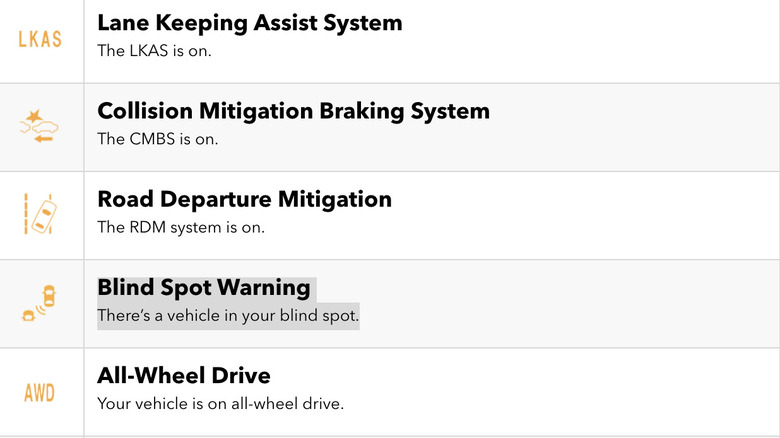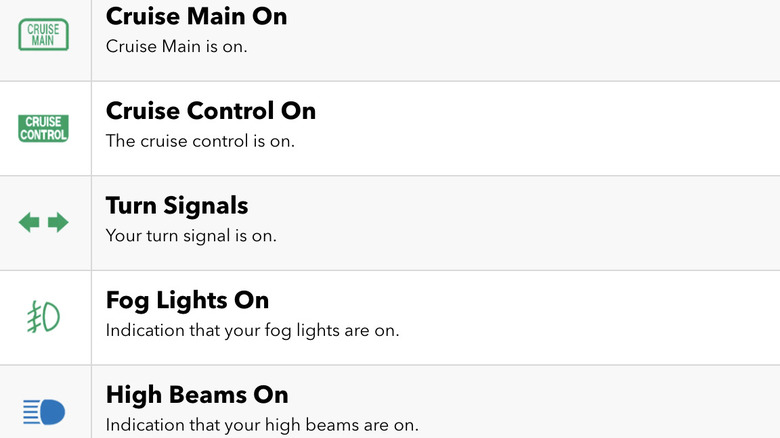Honda Warning Lights: What Each Symbol Means And How To Interpret Their Colors
Automotive technology has advanced light years since Carl Benz built the world's first automobile in the late 1800s and Henry Ford made cars accessible to the average American after the turn of the century. Modern automobiles have engines many times as powerful as the Model T's four-stroke T-4, which, though advanced for its time, produced just 22 horsepower. To manage the electronic fuel injection, anti-lock braking systems, and other modern features that make 21st Century cars so complex requires a powerful array of computers that are also often able to tell us when something is wrong.
This warning information is communicated via a set of dashboard warning lights and messages, which range from obscure-colored symbols to text that literally spells out the problem. Many dashboard warning messages come in the form of symbols and glyphs, some of which are easier to interpret than others. To add to the confusion, some of the warnings are simply helpful indicators, while others mean you have a serious issue that requires you to stop driving and get service immediately. Honda sold more than four million vehicles globally each year from 2013 to 2022, and if you're one of the many millions of drivers behind the wheel of a Honda, read on to learn how to interpret the lights on your dashboard.
Stop your Honda immediately if your check engine light is flashing
Honda's warning lights are color-coded to convey the urgency of the warning. Blue or green lights are informational, usually indicating that a system is active, while amber or red lights are there to warn you of a malfunctioning system that requires attention. The graphic above shows some of the warning lights you might see on the dashboard of your Honda, but there are many others you should be aware of. The most serious dashboard indicator is a flashing check engine light. This warning light looks like an engine block and will glow steadily when your car's computer has logged an on-board diagnostics (OBD) trouble code. These codes can come up for anything from a loose gas cap to a bad transmission, but a flashing check engine light on your Honda's dashboard indicates an engine misfire.
This means unburned fuel is being sent through your exhaust system. This condition can destroy your catalytic converter, which is expensive to replace. If your check engine light is flashing, stop driving immediately and have your car towed to a repair facility immediately. The problem can be as simple as a bad spark plug or loose plug wire, but it's best to have the issue addressed as soon as possible.
Oil pressure and brake system warning lights should not be ignored
Other warning lights that absolutely should not be ignored are the low oil pressure and brake system warning lights. The oil pressure warning light looks like an old-school oil can, and the brake system warning symbol is a circle surrounded by parentheses with an exclamation point inside. This light is different from the text warning reading "brake," which is just an indication that your parking brake is engaged. If you see the red circle with the exclamation point, pull over immediately and have your car towed to a repair facility.
Another warning light that requires you to stop driving and get service immediately is the supplemental restraint system warning, which is an icon of a person in a seat with a circle representing a deployed air bag near the head. This light indicates a potential issue with the air bags that could prevent them from protecting you in a crash.
You should also stop driving and get service immediately if your charging system warning light illuminates. This light is a car battery icon; essentially a rectangle with positive (+) and negative (-) symbols on it. A charging system failure isn't a safety issue like a supplemental restraint system malfunction, but could leave you stuck in a dangerous location. Another warning light that isn't to be ignored is the high temperature warning light. This indicator is a red "H" next to an icon of a thermometer in water. Overheating can destroy your engine quickly, so pull over and get service immediately if you see this light.
Seat belt and tire pressure warnings should be dealt with immediately
Your Honda will display a similar warning light if engine operating temperature is too low. The low temp warning light is a blue "C" next to the same thermometer in water icon as the high-temp warning light. Low engine temperature is sometimes an indicator of a malfunctioning or stuck thermostat, but can sometimes simply mean your engine hasn't warmed up enough in cold conditions. The problem might also be with the temperature sensor or related wiring, but you could also have a radiator fan that is running constantly. If this is the case, getting the problem fixed quickly is important. If your radiator fan fails from running constantly, your car could overheat quickly in stop-and-go traffic. Another warning light you shouldn't ignore is the seat belt reminder, which means one or more occupants of the car don't have their belt fastened properly.
Other safety-related warning lights include open door and trunk warnings, which are red icons showing open doors or an open trunk lid. The tire pressure warning light, which looks like a bulging tire as viewed from the front with an exclamation point inside, is another warning you should address immediately. Low tire pressure can make your car harder to control and bring to a stop, and will damage your tires if driven on for too long in this condition. A yellow gas pump icon means you are low on fuel and should stop for gas soon.
Some Honda warning lights are for driver assist systems
A yellow warning light that looks like a fountain in front of an arced water tank indicates that your washer fluid level is low. A yellow car icon with squiggly lines extending to the front indicates that your car's Vehicle Stability Assist, or VSA, system is activated or malfunctioning. A yellow steering wheel with an exclamation point next to it means there is a problem with your power steering system. These issues shouldn't be ignored for too long. A sudden loss of power steering assist can cause you to lose control of the car and have an accident. If your car has the capability, a yellow warning light will also appear on your dashboard to let you know another car is in your blind spot. This light shows two car icons at a 45-degree angle to each other, with two arcs below and to the left of the larger car.
Another series of yellow lights will appear when certain systems are active. The letters "LKAS" indicate your lane-keeping assist function is working, and an "AWD" light tells you your car is in all-wheel drive mode. A light that shows two cars front-to back with a star between them indicates your automatic collision avoidance braking system is working, and an icon showing a car crossing a lane boundary means the road departure mitigation (RDM) system is active.
There are several lamp-related indicator lights on the dash of a Honda
Another set of green and blue lights are there simply to let you know that certain functions are active. Green "Cruise Main" and "Cruise Control" text symbols tell you those systems are in use, and a green lamp with a squiggly line with hash marks through it means your fog lights are on. A blue lamp with horizontal line indicates your high beams are in use, and two smaller lamps with diagonal lines extending outward means your exterior lights are on. Blinking green arrows are your turn signal and hazard indicators, and a headlamp light with an "A" inside it means your automatic high beams are active.
A green leaf symbol means your car is in Economy mode, a yellow wrench indicates it is time for routine maintenance, and a lower case yellow "i" in a circle means there is an additional informational message on your multi-function display. A yellow circle inside parentheses with the letters "ABS" inside indicates a problem with your anti-lock braking system, and usually comes on in conjunction with the brake system light. If you see a green key icon, this means your car's immobilizer is active, which usually means it's not recognizing the chip in your key or fob. Charts to help you identify your Honda's warning lights are available on many dealership websites, and you can also consult your owner's manual for the meanings of the various pictographic warnings.
